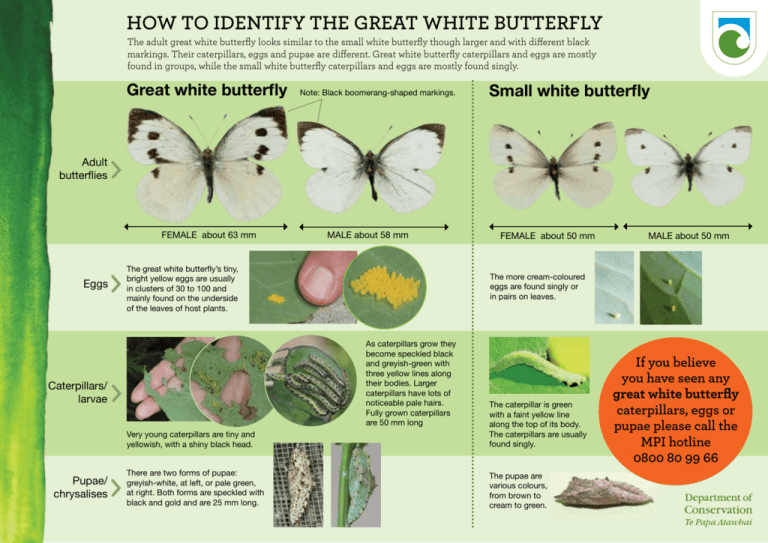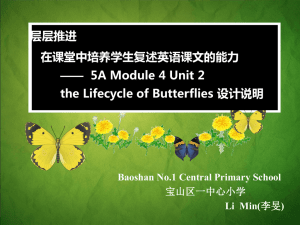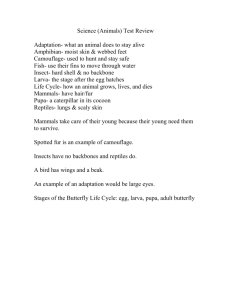Great white butterfly identification sheet
advertisement

How to identify the great white butterfly The adult great white butterfly looks similar to the small white butterfly though larger and with different black markings. Their caterpillars, eggs and pupae are different. Great white butterfly caterpillars and eggs are mostly found in groups, while the small white butterfly caterpillars and eggs are mostly found singly. Great white butterfly Note: Black boomerang-shaped markings. Small white butterfly Adult butterflies FEMALE about 63 mm Eggs The great white butterfly’s tiny, bright yellow eggs are usually in clusters of 30 to 100 and mainly found on the underside of the leaves of host plants. FEMALE about 50 mm MALE about 50 mm The more cream-coloured eggs are found singly or in pairs on leaves. As caterpillars grow they become speckled black and greyish-green with three yellow lines along their bodies. Larger caterpillars have lots of noticeable pale hairs. Fully grown caterpillars are 50 mm long Caterpillars/ larvae Pupae/ chrysalises MALE about 58 mm Very young caterpillars are tiny and yellowish, with a shiny black head. The caterpillar is green with a faint yellow line along the top of its body. The caterpillars are usually found singly. There are two forms of pupae: greyish-white, at left, or pale green, at right. Both forms are speckled with black and gold and are 25 mm long. The pupae are various colours, from brown to cream to green. If you believe you have seen any great white butterfly caterpillars, eggs or pupae please call the MPI hotline 0800 80 99 66 Great white butterfly host plants These are some of the plants favoured by the great white butterfly on which its caterpillars and eggs can be found. Some of these plants may be growing wild in your garden without you even knowing. Brassica vegetables Other plants Broccoli Cabbage Cauliflower Kale incl. cavolo nero Brussels sprouts Turnip Bok choy Pak choy Mizuna Rocket Swede Watercress Mustard Wild brassica Choho Misome Rape Kohlrabi Horseradish If you believe Radish Nasturtium Honesty – also called money plant Stock Wallflower Nasturtium butterfly hotspots The great white butterfly sets up breeding sites in large patches of overgrown nasturtium, which are being removed where possible to stop these breeding hotspots. • Please remove or cut back nasturtium in your garden. If you don’t want to fully remove nasturtium, please keep checking these plants for caterpillars and eggs and report any found to the MPI hotline 0800 80 99 66. • Please report patches of wild, overgrown nasturtium to the great white butterfly team at DOC’s Nelson District Office, phone (03) 546 3147 or email greatwhitebutterfly@doc.govt.nz. The caterpillars and eggs are often found on honesty, also known as the money plant, which grows in many gardens. Photo: Christmasnotebook.com you have seen any great white butterfly caterpillars, eggs or pupae please call the MPI hotline 0800 80 99 66 To find out more Visit www.doc.govt.nz or contact: Great white butterfly eradication team Ph: (03) 546 3147 Email: greatwhitebutterfly@doc.govt.nz Department of Conservation Nelson District Office 186 Bridge Street Nelson 7010 Ph: (03) 546 9335 Nasturtium Published by: Department of Conservation Nelson District Office Private Bag 5, Nelson 7042 New Zealand November 2013 Editing and design: Publishing Team, DOC National Office All images, unless otherwise credited, are by Richard Toft This publication is produced using paper sourced from well-managed, renewable and legally logged forests.






